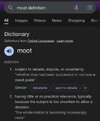I want to be clear here, I don't intend to seem like I'm arguing in this thread, but I think it's pretty fair to acknowledge the difference between assumptions and facts.
This is a topic I have studied for more than 20yrs, and I've NEVER seen anyone proving that concentricity is critical to precision, but I HAVE seen hundreds of people in dozens of threads like this claiming that "common sense" proves it... But I think it's pretty fair to ask folks to support their hypothesis - their common sense assumptions - to PROVE their claims, OR just acknowledge that assumptions based on common sense aren't always correct...
I WOULD ABSOLUTELY LOVE TO LEARN SOMETHING IF ANYONE ON THIS FORUM OR ANY OTHER COULD PRODUCE DATA WHICH REFLECTED DEFINITIVE ANSWERS TO THE HYPOTHESES BELOW.
I could probably use a little common sense and suggest that if I moved the bullet back and forth a few times the case would loosen up a bit and since the brass won’t resize itself or have enough spring back the case neck would remain opened up that wee bit.
I might be wrong .. I just haven’t taken note
This is making compounding assumptions that the bullets are bending far enough in the context of this discussion that the case won't spring back, and the assumption that the bullet and case neck are not moving together, but rather that the bullet is only moving part of the neck when being bent (in other words, assuming that the bullet is strong enough to "waller" the neck around to loosen it, but NOT strong enough to bend the entire neck)... Assumptions without data remain to be assumptions.
If you're willing to measure your runout, as you bend the cases and then measure your neck diameters, then you'd have proof to support the assumptions. But folks are promoting a lot of assumptions as if they were based in data and fact, rather than simple speculation. Common sense is great, but as we've seen in this thread, common sense would say that concentricity is critical to precision... But we have several experiments shown in this thread which show concentricity is NOT critical to precision...
Anyone with a 21st century Hydropress, K&M Force Pack Press, or AMP Press can test the change in break-free force after bending bullets and case necks. Anyone with a micrometer can measure OD of case necks after bending bullets and case necks. Just as the folks in these videos and articles conducted the experiments to test their hypothesis that concentricity influences accuracy and ended up with data which defied common sense, it would be exceptionally simple to conduct the measurements to prove or disprove the hypothesis that straightening bent ammunition reduces neck tension, and just as easy to prove the subsequent hypothesis that that change in neck tension would influence precision of the ammo...
Otherwise, we're all just assuming it's important and we're falling into the trap of the observational bias of assuming our assumptions are correct, and then stating them as facts...
I don't KNOW whether bullets seated with common equipment will have such eccentricity that when they bend straighter against chambers and leades that it would loosen their neck tension, because I have never seen data which showed case necks were stretched looser by the act of them being chambered and straightened. But I do know that as I've measured hundreds and hundreds of rounds for concentricity in the past, I didn't get a measurable change in the neck diameters based on the position of my dial indicators on the necks. I also know I didn't see any difference in precision when I used the hornady tool to straighten ammo vs. shooting raw "crooked ammo," and I didn't see any difference in precision when I shot groups of culled ammo vs. raw "crooked ammo." I also KNOW what we have seen in the videos and articles linked in these threads, and those presented in dozens of other threads like this... So I'm NOT prone to assume that 1) concentricity significantly influences precision, and 2) that the straightening of the ammo by the rifle negatively influences neck tension or resulting precision.
I WOULD ABSOLUTELY LOVE TO LEARN SOMETHING IF ANYONE ON THIS FORUM OR ANY OTHER COULD PRODUCE DATA WHICH REFLECTED DEFINITIVE ANSWERS TO THE ABOVE HYPOTHESES.
These are simple tests to do. A lot of folks can do them.
"Trust in God. All others, bring data."


